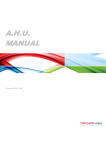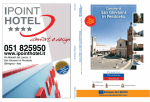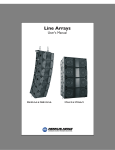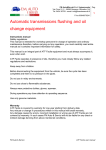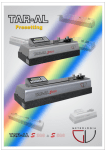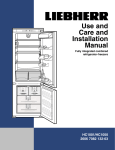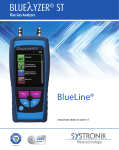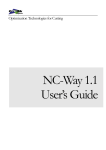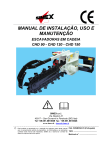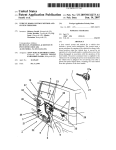Download Untitled
Transcript
2 INDEX 1 Characteristics................................................................................................................4 2 What the Kit Includes .....................................................................................................5 3 How to Choose the Heat Exchanger .............................................................................5 4 Functional Scheme and Probes Position .....................................................................7 4.1 (8-10) HP .......................................................................................................................7 4.2 (13-16) HP .....................................................................................................................8 4.3 (20-25) HP .....................................................................................................................9 5 AHU Kit Control Method...............................................................................................11 5.1 Fresh Air Only ..............................................................................................................11 5.2 Room Air Recycle and Adjustable Fresh Air Ratio.......................................................14 6 Electrical Connections .................................................................................................15 6.1 (8-10) HP .....................................................................................................................15 6.2 (13-16) HP ...................................................................................................................16 6.3 (20-25) HP ...................................................................................................................18 7 Electrical Diagram ........................................................................................................20 7.1 (8-10) HP .....................................................................................................................20 7.2 (13-16) HP ...................................................................................................................21 7.3 (20-25) HP ...................................................................................................................24 8 Dimensions Kit Components.......................................................................................27 9 Wiring Example of AHU Control System ....................................................................29 10 Switch Setting .............................................................................................................31 11 Optional .......................................................................................................................34 11.1 Analogue Temperature Setting Converter CS31 .......................................................34 11.2 Soft Starter................................................................................................................34 12 Frequently Asked Questions .....................................................................................35 13 Applications ................................................................................................................36 3 1. Characteristics 8 HP Kit Nominal Cooling Capacity: 22.4 kW Nominal Heating Capacity: 25.0 kW Maximum Heating Capacity: 26.5 kW On-Off Fan Speed Control 10 HP Kit Nominal Cooling Capacity: 28.0 kW Nominal Heating Capacity: 31.5 kW Maximum Heating Capacity: 33.5 kW On-Off Fan Speed Control 13 HP Kit Nominal Cooling Capacity: 35.5 kW Nominal Heating Capacity: 40.0 kW Maximum Heating Capacity: 42.5 kW On-Off Fan Speed Control 16 HP Kit Nominal Cooling Capacity: 45.0 kW Nominal Heating Capacity: 50.0 kW Maximum Heating Capacity: 53.0 kW On-Off Fan Speed Control 20 HP kit Nominal Cooling Capacity: 56.0 kW Nominal Heating Capacity: 63.0 kW Maximum Heating Capacity: 67.0 kW On-Off Fan Speed Control 25 HP kit Nominal Cooling Capacity: 71.0 kW Nominal Heating Capacity: 80.0 kW Maximum Heating Capacity: 84.0 kW On-Off Fan Speed Control 4 2. What the kit Includes The Kit is made up by: (8-10) HP - Control Box: It includes the boards to control the expansion valves and to control the AHU fan (with Fan Soft Starter Controller if required); - 1 Electronic Expansion Valves Assembly (strainers are just installed); - Probes and Capacity Adapter. (13-16) HP - Control Box: It includes the boards to control the expansion valves and to control the AHU fan (with Fan Soft Starter Controller if required); - 3 Electronic expansion valves; - 6 Strainers to protect the valves; - Copper Branches Set to joint the refrigerant components. (20-25) HP - Control Box: It includes the boards to control the expansion valves and to control the AHU fan (with Fan Soft Starter Controller if required); - 3 Electronic expansion valves; - 6 Strainers to protect the valves; - Copper Branches Set to joint the refrigerant components. 3. How to Choose the Heat Exchanger 8 HP Permitted volume from 4,6 dm³ to 6,6 dm³ 10 HP Permitted volume from 6,5 dm³ to 8 dm³ Cooling Mode - Saturated Suction Equivalent Temperature 7°C - Refrigerant Superheating 5°C Heating Mode - Saturated Condensing Equivalent Temperature 45°C - Refrigerant Supercooling 5°C 13 HP Permitted volume from 6 dm³ to 8 dm³ 16 HP Permitted volume from 7.5 dm³ to 9 dm³ 5 Cooling Mode - Saturated Suction Equivalent Temperature 7°C - Refrigerant Superheating 5°C Heating Mode - Saturated Condensing Equivalent Temperature 45°C - Refrigerant Supercooling 5°C The configuration of the heat exchanger is standard with two pipes. Since the cooling operation, there is also the distributor of the liquid on the tube. 20HP Permitted Volume from 9 dm³ to 11 dm³ 25 HP Permitted Volume from 10 dm³ to 13 dm³ Cooling Mode - Saturated Suction Equivalent Temperature 7°C - Refrigerant Superheating 5°C Heating Mode - Saturated Condensing Equivalent Temperature 45°C - Refrigerant Supercooling 5°C The heat exchanger is divided in two parts. The first part is design for the 2/3 of capacity the second one for the remaining part. The air goes through the bigger part then crosses the smaller part (see the figure below). 6 4. Functional Scheme e Probes Position 4.1 (8-10) HP The AHU (8-10) HP Kit requires a standard refrigerant circuit with a single circuit heat exchanger, the same used for DX indoor units. Cooling Mode The liquid refrigerant reaches the expansion valve through the strainers. It evaporates in the heat exchanger and then, as vapour, comes back to the GHP. Heating Mode The vapour reaches the heat exchanger, here it condensates and come back to the GHP through the strainers and the expansion valve. 7 4.2 (13-16) HP The AHU (13-16) HP requires a standard circuit of the refrigerant gas with coil in a single circuit, the same type used in direct expansion indoor units. a heating Cooling mode The liquid refrigerant reaches the expansion valve through the filters, evaporated in the heating coil and then the vapour state, returns to the outdoor unit. Heating mode The refrigerant gas to the gas phase reaches the heat exchanger, including condensate and returns to the outdoor unit through the filters and the expansion valve. 8 4.3 (20-25) HP Cooling Mode The liquid refrigerant reaches the three-pipe joint and there is divided. 1/3 of the refrigerant goes through the strainers and the expansion valve and reaches a small distributor. The 2/3 goes through the two expansion valves and the small branch joint and reach the big distributor. After the heat exchanger the refrigerant flows through the big branch joint to the GHP. Heating Mode The refrigerant is split by the big branch joint and then it reaches the heat exchanger. In liquid form it goes through the distributors, expansion valves and three pipe joints to the GHP. 9 10 5. AHU Kit Control Method The aim of this document is to provide information about the AHU control method. It also provides an easy reference to select the proper combination with indoor units. The AHU kit is designed to be suitable for two types of installation layout. Fresh air only (all the processed air flow is taken from outside); Room air recycle and adjustable fresh air ratio (most of the processed air is taken from inside); 5.1 Fresh Air Only When this configuration is selected, the AHU works the intake air to the building in series with a heat recovery unit. This means only part of the overall load is covered by the AHU. The remaining load is managed by standard indoor units. In fact, in heating mode the AHU heat exchanger capacity varies with the air intake temperature and precisely it drops when the intake temperature increases. On the contrary, the capacity of the indoor units is quite constant (see graph 1). As a consequence of selecting this configuration, the AHU cannot control the air discharge temperature. Therefore, the provided capacity depends only on the size of the heat exchanger. It is possible to manage the room temperature by controlling the indoor units, which can vary their capacity by adjusting the room set temperature. In case of high outdoor temperatures, it is anyway possible to switch the AHU to fan mode and let the indoor units manage the room temperature (See graph 2). 11 The AHU kit is not designed to be the only unit to control room temperatures. It is always necessary to install indoor units. In fact, in case the AHU is the only heating device, when delivered capacity is higher than the building need, problems in temperature management occur. The following example shows that when room temperatures exceed T1, room overheating, discomfort and consequently excessive gas consumption occur. 12 In cooling mode the control method is the same but the heat exchanger capacity increases with outdoor temperature. 13 5.2 Room Air Recycle and Adjustable Fresh Air Ratio When this configuration is selected, it is only necessary to verify the nominal capacity at rated conditions, which are given in the project. The AHU kit modulates the delivered capacity to ensure comfort temperatures. This delivered capacity drops to zero when the set temperature is reached. Generally speaking, designers always keep the fresh air ratio within the range of 0 and 30 %. 14 6. Electrical Connections 6.1 (8-10 ) HP Here under the control box terminal block. L-N: AHU Power Supply From Y1 to Y6: Electronic Expansion Valve R3-R4: Gas Pipe Temperature Sensor R1-R2: Liquid Pipe Temperature Sensor R5-R6: Intake Air Temperature Sensor P1-P2: Remote Controller F1-F2: Bus Line (to GHP) T1-T2: Digital Input On-Off Control C1-C2: Fan Control (Maximum 230V – maximum 2 A) Note: A special harness to joint the wires from Y1 to Y6 is just included in the Electronic Expansion Valves Assembly Box. Input-Output Board contacts A+ A-: Temperature Setting Analogue Input (see Switch setting chapter) BC-B1-B2: Control Digital Input (see Switch setting chapter) W1-W2: Operation Digital Output (free contact) W3-W4: Error Display Output (free contact) 15 6.2 (13-16) HP Here under the terminal block is divided in order to show better the connection labels. Notes: Explanations in RED are for electrical contacts made during the AHU construction. Explanations in BLUE are for optional contacts. Explanations in GREEN are for contacts made during the AHU installation The Expansion Valves connection is made using special harnesses, included in the kit, in order to avoid wrong wiring X13A : Intake Air Temperature Sensor X12A : Higher Contacts : Liquid Pipe Temperature Sensor X14A : Discharged Air Temperature Sensor X11A : Higher Contacts : Gas Pipe Temperature Sensor P1-P2 : Optional Second Remote Controller F1-F2 : Bus Line (To GHP) T1-T2 : OnOff or Forced Off Contact X7A-1 : Expansion Valves Controller 16 B1B2BC : Digital Input A+A- : Temperature Setting Analogue Input GND-MP-MP-MP Fan Motor Power Supply (three phase) GND-LR-LS-LT-LN AHU Power Supply GND-MP-MP Fan Motor Power Supply (single phase) These are the X7A Connector (already wired in the electrical box) T2A-N2 : Soft Starter Power Supply The electrical box can be equipped with a soft starter device. It permits to give power to the fan kindly, avoiding overpressure in the duct 17 6.3 (20-25) HP Here under the terminal block is divided in order to show better the connection labels. Notes: Explanations in RED are for electrical contacts made during the AHU construction. Explanations in BLUE are for optional contacts. Explanations in GREEN are for contacts made during the AHU installation The Expansion Valves connection is made using special harnesses, included in the kit, in order to avoid wrong wiring X13A : Intake Air Temperature Sensor X12A : Higher Contacts : Liquid Pipe Temperature Sensor (Big Heat Exchanger Part) X12A : Lower Contacts : Liquid Pipe Temperature Sensor (Small Heat Exchanger Part) X14A : Discharged Air Temperature Sensor X11A : Higher Contacts : Gas Pipe Temperature Sensor (Big Heat Exchanger Part) X11A : Lower Contacts : Gas Pipe Temperature Sensor (Small Heat Exchanger Part) P1-P2 : Optional Second Remote Controller F1-F2 : Bus Line (To GHP) T1-T2 : OnOff or Forced Off Contact X7A-1 : Expansion Valves Controller (Big Heat Exchanger Part) 18 X7A : Expansion Valve Controller (Small Heat Exchanger Part) B1B2BC : Digital Input A+A- : Temperature Setting Analogue Input GND-MP-MP-MP Fan Motor Power Supply GND-LR-LS-LT-LN AHU Power Supply These are the X7A Connector (already wired in the electrical box) T2A-N2 : Soft Starter Power Supply The electrical box can be equipped with a soft starter device. It permits to give power to the fan kindly, avoiding overpressure in the duct 19 7. Electrical Diagram 7.1 (8-10) HP 20 7.2 (13-16) HP Sheet 1 21 Sheet 2 22 Sheet 3 23 7.3 (20-25) HP Sheet 1 24 Sheet 2 25 Sheet 3 26 8. Dimensions Kit Components Attached the AHU Kit Components dimensions Copper Branches kit AHU (20-25) HP Copper Branches kit AHU (13-16) HP 27 Electrical Box Electrical box dimensions: 65cm x 42cm x 20 cm (The cover is not shown) (*) (*) For AHU (25-20-16-13) HP Strainers Each strainer is 13cm long - N°6 for AHU (25-20) HP - N°4 for AHU (16-13) HP Expansion valves Each expansion valves is provided with two copper pipe 5cm long - N°3 for AHU (25-20) HP - N°2 for AHU (16-13) HP 28 9. Wiring Example Of AHU Control System AHU can be managed by: ‐ Standard Remote or Central Controller according with the attached AISIN and DAIKIN user manual. If a further remote controller is installed remember to set it “slave” ‐ BMS Digital And Analogue Input according with the follow chapter “Switch setting” ‐ Forced OFF Digital Input (T1T2) 29 If is installed an I-Touch centralized control, add the card DTA109A51 30 10. Switch Setting The EC9432 (D) board is installed in electrical box upper part, under the AISIN remote controller. You need to remove it from the DIN bar before making any operation. Default setting: SS1 – NON VOLT SS2 – POSSIBLE RS1 – POSITION 0 A+A- Temperature Setting Input To enable the temperature setting from remote controller and from the contact A+A- set the SS2 Switch to POSSIBLE. IMPOSSIBLE setting don’t permit to use the remote controller for temperature setting. For any reason is not permitted to apply voltage to the A+A- terminal block. The relationship between setting temperatures and resistance value is shown in the table Set 16 17 18 19 20 21 22 23 24 Temp 0 5 13,8 22,4 31,0 39,4 48,2 56,6 65,2 Ohm ÷ ÷ ÷ ÷ ÷ ÷ ÷ ÷ ÷ 3,4 11,6 20,0 28,4 36,4 44,8 52,8 61,2 69,4 Set 25 Temp 73,8 Ohm ÷ 77,8 26 27 28 29 30 31 32 82,4 91,0 99,4 108,6 117,2 125,8 134,2 ÷ ÷ ÷ ÷ ÷ ÷ ÷ 85,8 94,0 102,2 110,4 119,2 127,4 140,0 31 B1B2Bc Input Input With Voltage Set the switch SS1 to VOLT and use 12-24 V Direct Current. No polarity Input With No Voltage Set the switch SS1 to NON VOLT and use a vinyl sheathed cable of 0.18 mm² or more. The total length should be less than 150 m Setting Of Control Mode Rotary Switch RS1 Functions description: Remote Control Rejection : You can turn ON/OFF only by central controller Remote Controller OFF Only Accepted : You can turn ON/OFF by central controller, you can turn only OFF from remote controller Central Priority : You can turn ON only by central controller and from remote controller only during the set time Individual Priority : You can turn ON/OFF by both central controller and remote controller Remote Controller Permission Timer : You can turn ON/OFF by remote controller during set time. 32 RS1 Position Functions 0 Input Ignored 1 Remote Control Rejection 2 Central Priority 3 Remote Control Acceptance/Rejection 4 Remote Control Acceptance/Rejection, OFF 5 Remote Control Rejection 6 Last Command Priority 7 Remote Control Rejection 8 Last Command Priority 9 Remote Control OFF Acceptance A Remote Control Acceptance/Rejection, OFF B Last Command Priority C D E F Position 5 + Energy Saving Control Position 5 + Temperature Set Back Position 6 + Energy Saving Control Position 6 + Temperature Set Back Description Of Operation Input Between B1 - Bc - Input Between B2 - Bc - Start at ON, Stop at Off Start at ON (remote control acceptance) Stop at OFF (remote control rejection) Stop at ON (remote control The same as position 1 rejection), input B1 – Bc (only stop is accepted by acceptance at OFF remote controller) Start at ON (remote control acceptance) Stop at OFF (remote control rejection) Start/Stop (Repeats) The same as position 5 Stop at ON (remote control acceptance) Start at OFF (remote control rejection) Start at ON Stop at ON Start at ON (remote control Stop at ON (remote control acceptance) rejection) The same as position 7 (only stop is accepted by The same as position 7 remote controller) Start at ON (remote control Stop at ON (remote control acceptance) rejection) The same as position 7 (remote control The same as position 7 acceptance) Forced thermostat OFF at ON The same as position 5 Setting temperature command at ON shift Forced thermostat OFF at ON The same as position 6 Setting temperature command at ON shift NOTE: When constant input is used for input B2Bc at position 7 ÷ A, the system is shut-down forcibly (input B1Bc ignored) 33 11. Optional 11.1 Analogue Temperature Setting Converter CS31 This optional board permits to control the AHU temperature setting using 0-10 VDC analogue input according to the table below Set 16 17 18 19 20 21 22 23 24 Temp Volt 0,85 1,71 2,52 3,33 4,02 4,71 5,32 5,92 6,49 Set 25 26 27 28 29 30 31 32 Temp Volt 7,00 7,49 7,94 8,34 8,76 9,18 9,54 10 Electrical Connection 5-6 : Board Power Supply 24 Vac (Max 5VA) 1-2 : 0-10 VDC Analogue Input 3-4 : Ohm Analogue Output (It has to be connected to A+ A- terminal block in the EC9432 (D) board ) Note: The green led indicates that the board is power supplied 11.2 Soft Starter This optional is a compact fan motor controller that permits you to avoid overpressure in duct systems. It works reducing the initial motor torque and increasing it step by step till nominal value. We recommended with fabric duct or when noise reduction during the fan initial operation is required. 34 12. Frequently Asked Questions - Where is it used? The DX AHU is the best solution where there is the need to supply heating and cooling capacity to open spaces like warehouses, sport arenas and commercial building. -Which are the best advantages of an AHU? This kind of indoor unit permits to provide a huge capacity in a very easy way, in fact it’s no more necessary to install the Yoshi AWS and a complete water loop. The installation costs are strongly reduced and the technical rooms disappear. Besides the DX technology guarantees the highest efficiency. - Which are the disadvantages of an AHU? The only disadvantage of an DX AHU is related to its control. In fact in all the applications where the humidity ratio control is required, the water system are the only solution. (Data and information contained in this booklet are valid for direct expansion installations and are subject to changes without prior notice) 35 13. Applications San Giovanni In Persiceto (Bologna) Italy This system is made up by n°8 GHP 25 HP, each of them is connected to one AHU Customer Advantages: ‐ Installation cost is very low ‐ Installation spaces are strongly reduced ‐ There are no dead time to provide capacity ‐ The running costs are lower than a traditional water plant ( GUE is higher and there is no pump energy consumption ) 36 NOTES 37 38 39 40








































